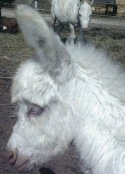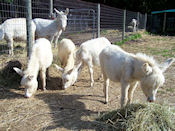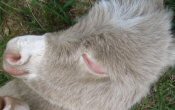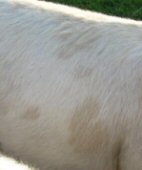Ivory Donkey Genetics
A basic introduction
written by Connie BonczekThis page is intended solely to provide basic information regarding ivory (also incorrectly referred to as blue eyed whites, bews) donkey genetics.
A true ivory miniature donkey will have pink skin and 2 tone blue eyes (ice blue iris). The coat color is cream/off-white, not white. On most adults, the cross is visible when they shed, on some however, it is not. It is common for ivory foals to have a darker coat color (dark cream or tan) with visible cross. Although some foals are born very light.
|
Lil Longears Casper
|

various shades of ivory
|

FBA Takota
|

Hickory Hill's Casper the Friendly
|
|
RJR's Krystal
|

RJR's Krystal
|
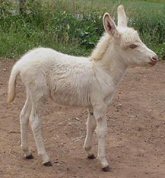
LFF's Caramel Creme
|
.jpg)
Cabinwood's Alexander the Great
|
|
|
FBA Calypso
|

FBA Takota
|
Cabinwood's Atticus
|

Merry-Go-Rounds Goldilock's
|
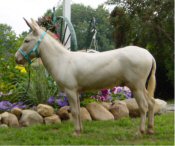
Merry-Go-Rounds Mr Perlino
|
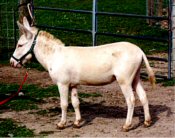
Merry-Go-Rounds Sir Booberry Creme
|

Furball Acres Kodiak
|
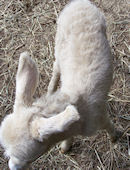
Cabinwood's Stryker
|
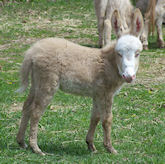
Cabinwood's Alexandria
|
Dogwood Hills Quicksilver
|

Mirage and Shadow
|
|
visible star
|

visible cross
|

adults & foals
|
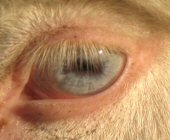
two tone blue eye
|
![]()
Although ivory donkeys have primarily pink skin, it is not unusual to see freckles, (small darker dots), on pink pigmented skin, around the eye, muzzle and genital area.

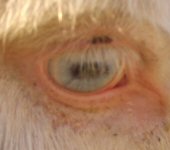
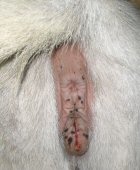
photo's courtesy of Connie B
![]()
In general- Ivory acts as a recessive gene; requires a dose from each parent to produce an ivory foal. Mating 2 ivories will always produce ivory. Crossing ivory to visual non-ivory (but carries the recessive ivory gene from a parent) will give a 50/50 chance for an ivory foal on each offspring. If ivory is further back in the lineage, the outcome can not be fully predicted. However, the gene can be carried down many more generations than you may think. This has been shown when an ivory foal is born to 2 non-ivory parents who were not known to carry the recessive gene.
The pictures below, are examples of gray dun/ivory recessive donkeys. All the dams are brown or gray dun, sire is ivory. Although their phenotype (outward appearance) shows no signs of ivory, their geneotype (genetic makeup) does. Because ivory acts as a recessive, it does not show phenotypically unless the donkey is homozygous for ivory (has 2 doses of ivory, one from each parent). Dominant genes, on the other hand, are expressed in either form; heterozygous(one dose) homozygous(2 doses). Therefore, the dominant gene hides/masks the recessive ivory gene in the donkeys phenotype. When these hidden/masked recessives pair up, you get the surprise ivory foals from 2 non-ivory parents!

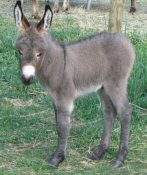
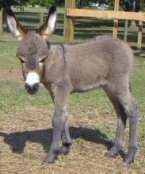
FBA foals, photo's courtesy of Connie B
The two pictures below are examples of ivory recessive donkeys. Again, their phenotype shows no signs of the ivory gene, however both are out of an ivory dam!
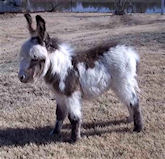

photo courtesy of owner, Lori Babcock-Wargo (Cabinwood Farm)
![]()
I have tried to keep my personal opinions away from this page, however, due to previous inbreeding of the ivories, I feel this paragraph is warranted. The gene pool for ivories is very limited. Therefore, it is my personal belief, which I carry out in our herd, to outcross ivories to non-ivories, retain offspring for future crossings to a non-related ivory or ivory carrier. By doing this, not only is the gene pool enlarged (ok slowly, but we're trying), much needed new blood lines are brought in. So if you are interested in ivory donkeys, I urge you to consider ones that are not ivory, but have an ivory parent. Remember, color is the icing on the cake only, be sure you have a good cake first!
![]()
There is currently no DNA genetic testing available for the ivory color. Hopefully, that will be an option in the future. Thus far, the ivory gene does not work like the Cremello or Perlino gene (incomplete dominant) in horses. Ivory donkeys are homozygous, no heterozygous effects have been noted. Read more about Why ivory isn't like the horse cream-gene, a very good article written by Leah Patton.
this paragraph reprinted from: The Brayer, volume 38: ADMS will continue to use the term Ivory and any visual identification of the animal; until tests have progressed to a point where gene identification can be assured. ADMS is currently working with 2 genetics labs to first isolate the gene for champagne in horses (which will rule out or confirm genes at that location for other dilutions) and then to positively test donkeys for cream, champagne and begin isolation of the Ivory and "Perla/Barlink" factors.
![]()
The myth that ivory donkeys can not hear is unfounded. Many assume they are deaf because they think they are white with blue eyes (comparing them to cats, dogs and others). A relationship between deafness and hypopigmentation exists across many species (humans, dogs, llamas, alpacas and cats), all of those being solid white with solid blue eyes. First of all, ivories are not white, (actually, a white star shows up quite well on an ivory), and I assure you, ivorys certainly can hear, very well mind you!
Can ivory donkeys see? Yes, of course they can! The blue eye seems to not 'filter' sunlight as well as a dark eye. Therefore, an ivory will often point their nose toward the ground when traveling into 'direct sunlight'. I have done various testing, walking them towards the direct sun (when it is preparing to set and is annoying to your own eyes), both with a visor cap and without, there is a big difference in how they hold their head. With a visor on, the head is held up high, without, the held is pointed down. We have moved gates, added and removed obstacles etc; yet they notice this immediately. On a bright sunny day, is it easy to see a few wire electric fence with poles set far apart? No it is not, and it's probably even more difficult for the blue eyes to see it as opposed to the dark eyes (not only the blue eyes though, that's why flags for electric fencing are made). {note: I am not referring to the older ivories that were so inbred, many of them had difficulties} Blue eyes result from lack of pigment in the iris, this does not affect the vision. Thus far the research, that I am aware of, points out they are similar to blue eyes in humans and may be more sensitive to sunlight, but have no health problems associated with them. Personally, I do feel they are more sensitive to sunlight.
Can they sunburn? Yes they can. Any pink skinned donkey can sunburn, which includes spotted. An ivory kept healthy, with worming up to date, has alot of hair on the ears and muzzle. Mine have never sunburned, and we are in a hot spring/summer climate. Yet I have a spotted jenny (minimal spots) that does sunburn easily. Regardless, they certainly need acess to shade, as all donkeys do.
![]()
There are now a couple of documented ivory spotted foals...how exciting!! Hopefully in a few years, we'll have more information here about breedings with them. I'm sure they will have their very own page soon :)
|
LFF Buttered Popcorn
|
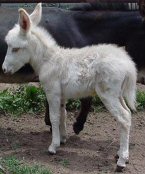
LFF Buttered Popcorn
|
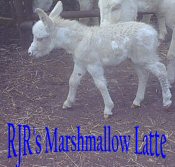
RJR's Marshmallow Latte
|
Cabinwood farms Lady Malinda |
|
Cabinwood farms Lady Malinda
|
RJR's Frosty
|

RJR's Frosty
|
I would like to say a special Thank You to Leah Patton, for her endless help, advice, sharing of knowledge and proofing of this page...."Thanks Leah"!!
![]()
|
|
|
|
|
|
Microchips- Destron Lifechip, NAIS approved, available at Light Livestock Equipment
Web Design by Connie Bonczek
Copyright © 2002-2008 Furball Acres All Rights Reserved
Furball Acres
Connie & Jim Bonczek
46 Calhoun St
Johnston, SC 29832
furballacres@nctv.com
803-275-4306

